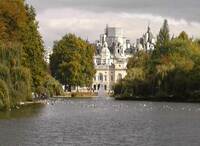- England
- Scotland
- France
- Holland
- Germany
- Italy
- Spain
- Portugal
- USA
- China
- Japan
- India
- Iran
- Advice
- Gardens
- England
- Scotland
- France
- Holland
- Germany
- Italy
- Spain
- Portugal
- USA
- China
- Japan
- India
- Iran
- Advice
- Garden Tours
Book: Landscape Planning and Environmental Impact Design: from EIA to EID
Chapter: Chapter 4 Public open space POS
Some parks need more-than-local funding. Cities require some parks which are great works of art. Government stock is safer than other types of stock. Government parks are better resourced than other types of park. Kings and queens used to make royal parks. Substantial resources are needed to create and maintain national works of art [Fig 4.16]. Park-making demands sustained effort, generation after generation after generation. At times, heavy expenditure is required and the very best designers must be employed. Continued maintenance by thoughtful people with excellent design judgement will then be necessary. Idealism must guide their efforts. Special laws may be required. After concluding a major study of American parks in the 1970s, Heckscher concluded that, 'the more local a government becomes, the less adequate is the level of maintenance. Where the state is responsible for inï¾city park development and upkeep (as, for example, in Point State Park in Pittsburgh or the historic park in San Diego's Old Town) high standards prevail' (Heckscher 1977: 9). Wherever one may stand on the political spectrum, and in whatever country, one can but acknowledge that those parks which are owned and maintained by monarchs, central governments and capital cities, have longer and better lives than those which are maintained by small communities with insecure tennancies. In Europe, many of the greatest 'public parks' began in the ownership of kings and princes and survive in the ownership of government departments, be they in Berlin, Rome, Paris, Barcelona or London. Britain 's Royal Parks were originally hunting forests, regulated by forest laws which gave rights, not unlike common rights, to forest dwellers. Despite the name 'forest', much of the land was grass and scrub. The crown had no interest in timber until the close of the middle ages (James 1981: 137). Hyde Park was acquired by Henry VIII in 1536 and opened to the general public by Charles I, in 1635, entirely 'by his Majesty's free will' (Larwood 1872: 21). No landscape design has ever been prepared for the whole park. It r ema ins in crown ownership but the deer were removed in the nineteenth century and the sheep in the twentieth century. Hyde Park now has the appearance of a municipal gark, except for the fact that over 250 horses are stabled near the park and exercised on Rotten Row. They are an elegant spectacle. Richmond Park is still managed as a deer park , though not for hunting. Deer, dogs and people have learnt the art of coexistence. It is an economical, and quite splendid, technique of park management. London 's other Royal Parks have been designed according to aesthetic criteria, but this tradition comes from Italy and France . Versailles was both a hunting park and a Royal Garden . Any man was free to enter the gardens, providing he wore a sword. Louis XIV's entourage merely cleared a path through the crowd. Gothein remarks that 'from the earliest days of the Renaissance it was customary in Italy for people who owned works of art and gardens to give the public free access to them' (Gothein 1928:334). Mumford notes that the royal parks were 'perhaps the first baroque feature to be opened to the public and duly incorporated in the city' (Mumford 1938: 379). Charles II returned to England from the court of Louis XIV and employed Frenchmen to advise on the design of St James's and Greenwich Parks . Like many European royal parks, they were opened to the public in the seventeenth century. The most important lesson to learn from the royal tradition is that a park can be conceived as a deliberate work of art. Even today royal parks escape the sameness of municipal management.
